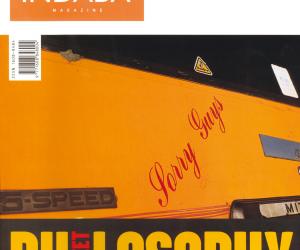First Published in

The haberdasher was eager to be first to introduce the latest Parisian fashion to his London fellows. He hurriedly recreated the top hat he had seen on his journey and took it outside his shop. It was 1797, and his fellow Londoners had never seen such a hat before. A crowd gathered and became unruly in order to get a glimpse of the creation. They pushed and shoved to get a clear view. Fights broke out and John Etherington was arrested for inciting a riot.
In 1940, Salvador Dali was on a steamship bound for New York City. Already well known as the leader of the Surrealist art movement, Dali planned for days his grand entrance to the New World. This would be his new home, and his entrance would be a birth pain to waken big, busy New York City. Dali talked the ship's chef into baking a six-foot long loaf of bread that he would carry ashore instead of luggage. As the ship docked, photographers were ready to capture the art-celebrity's arrival. The photographers took pictures, but to Dali's despair, no reporter bothered to ask about the tremendous loaf. Dali could not understand why the reporters failed to acknowledge his symbol of the bizarre. Were New Yorkers more surreal than even Dali?
Symbols evoke responses that seem intuitive, purely emotive. But the immediacy of meaning is a result of design. Has the symbol been developed with clear criteria based on knowledge of the audience's language, environment and community? Has the symbol been crafted in a way that ensures it will become an active part of the audience's language? John Etherington was in tune with the fashion trends of his homeland. He understood the need for 'ego-erecting' accessories for the Londoners who wanted to display the status that their empire's prosperity had bought. The top hat brought from Paris seemed perfect for his homeland, and it was. Etherington introduced a fashion of calculated significance that would last for two hundred years. But Dali was at odds with New Yorkers, never understanding how to get under their skin. He remained a celebrity, but only for being a famous European artist. He never affected New York City, which he claimed to have "invented in my dreams." New Yorkers don't refer to a six-foot loaf of bread as a statement of absurdity.
Symbols can seamlessly enter popular language. More than simple iconography, symbols can be developed to touch all the senses. What does it mean to hold a cross, a flag, olive branch, peace sign, to smell perfume, fly the Concorde? They are pervasive through our environments, being viewed as the environment itself. An item as functionally pure as the pencil comes in endless varieties. The brand names Ticondaroga and Dixon are descriptive beyond graphite and wood. Shell, BP and Elf have come to represent values in addition to selling petroleum. Selective conscious calls attention to a small portion of what surrounds us.
We live in an age of flux. The details of our environment change with every new technology, every new medicine and every new building. And every degree of change forces redefinition towards our environments and our peers.
The routines and roles necessary to hold communities intact often fall casualty to change. Communities are forced to evolve or disband. The evolution of language is critical for communities to remain intact. Giuseppi de Lampedusa captured this notion in his novel The Leopard, describing a small community fighting to retain their residential ways. "If we want things to stay as they are, things will have to change."
By nature, communities fight to remain intact. Dramatic change is uncomfortable, shocking and perhaps disrupting. Change threatens the members' roles and relations. Did you notice that your grandparents were the last ones to buy a phone answering machine? That they don't care to download an mp3 file?
In the 1870s, the commercial use of symbols exploded in the United States. Mass production kicked into high gear and distribution and packaging technologies all aligned to create the mass-consumer foods industry. Prior to this convergence, local merchants sold foodstuff from open boxes and barrels. The price of an item was determined by the apparent wealth of the customer. In addition, the merchant was often suspected of tipping scales and adulterating foods. Merchants were widely viewed as crooks. One early consumer brand was Quaker Oats. Although the oats were not manufactured or packaged by Quakers, the values of the manufacturer and desires of the consumers were aligned with the Quaker's ideals of honesty and virtue. The Quaker stood on the shelf pre-priced and pre-weighed, ready to compete for sales with the local merchant. Guess who won?
Commerce knows the value of symbols. It employs them to help sell products, to increase workflow, to inform analysts and influencers, to inspire employees. Trademark laws are the result of this grand alliance between symbol and commerce (to trademark is to own the right to a proprietary symbol within a realm of trade). This ownership right allows a company to manage its symbol equities with the same rigor it does other valued properties.
Companies become architects of popular language through branding, product development, marketing and public relations. The values of symbols can be molded over time. Careful investment, planning and management pays handsomely; the Coca-Cola brand name and icon are worth an estimated $70 billion dollars, the IBM brand name and icon some $50 billion dollars.
To have the right values associated with symbology often means the difference between profit and loss. GE currently purchases microwave ovens from Samsung, adds the GE brandmark, places the units in GE packaging and returns them to the market. There the GE ovens fetch substantially more per unit that the original Samsung machines. Brand symbology can work magic in the marketplace.
A key to commerce lies in the ability to become an active part of a community, crafting a lasting emotional bond with audiences, becoming part of popular language. Although a finely designed symbol does not necessarily live for eternity, a poorly designed one will certainly cost more to imbue with intentional meaning and manage over time. The ability of a designer to understand the needs and desires of an audience can mean the difference between the success and failure of a company.
Consider what Dali had said about his New World destination. New York, he said, was the city he had "invented in my dreams." In essence, this is pre-requisite for the successful launch of a symbol; to already be known and desired.
Michael Thibodeau is the New York Creative Director for FutureBrand. One of the largest brand consulting agencies in the world, FutureBrand is also the fastest growing.
Michael has consulted for a wide portfolio of clients including Microsoft, DuPont, Price Waterhouse Coopers and Coca-Cola and has written extensively on the subjects of branding and identity. He is author of the book "Smoke Gets In Your Eyes," a brief history of cigarette branding and packaging.
Michael is responsible for brand creation and environmental and print implementation on programs in the financial and professional services, e-commerce, travel, hospitality, technology and telecommunications sectors.







